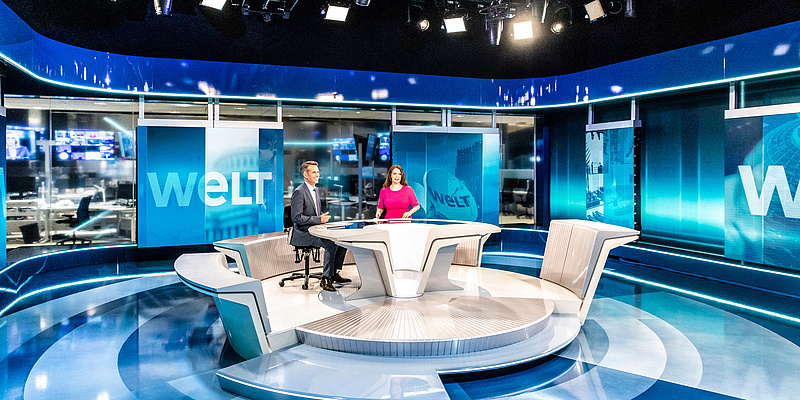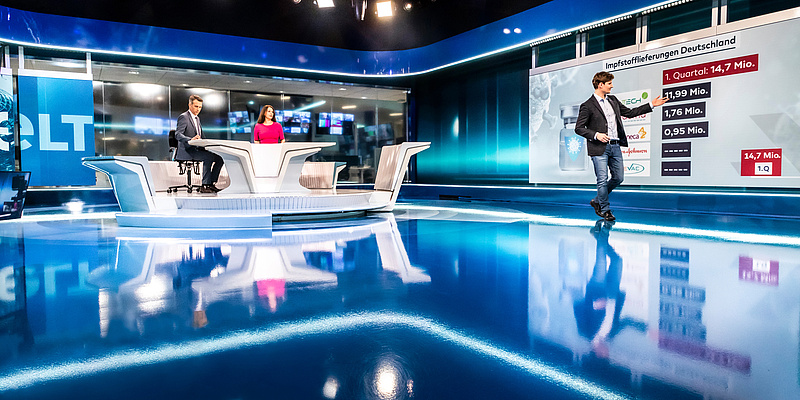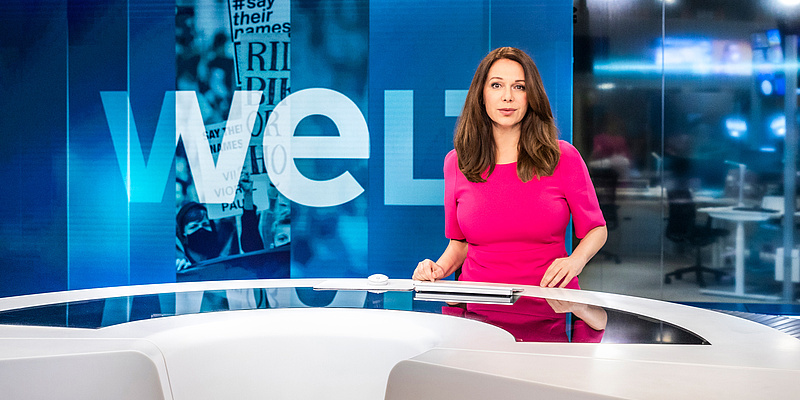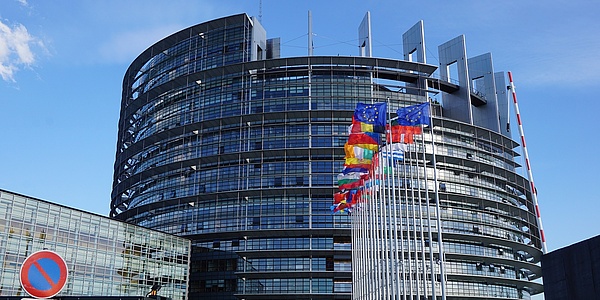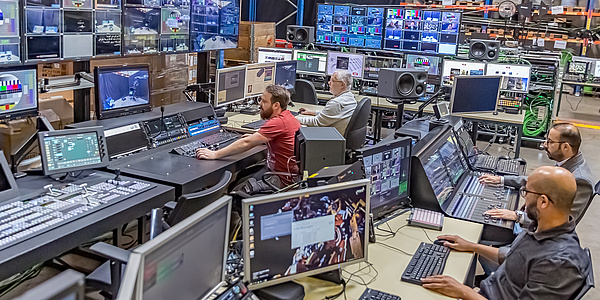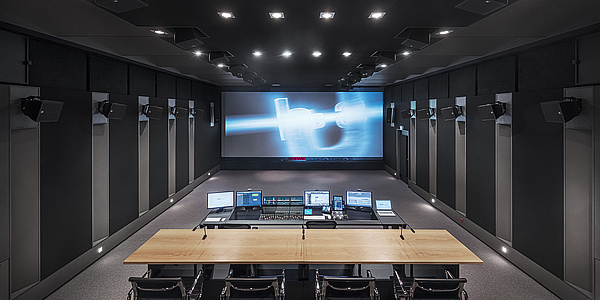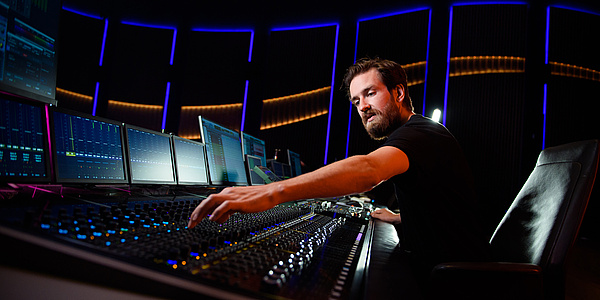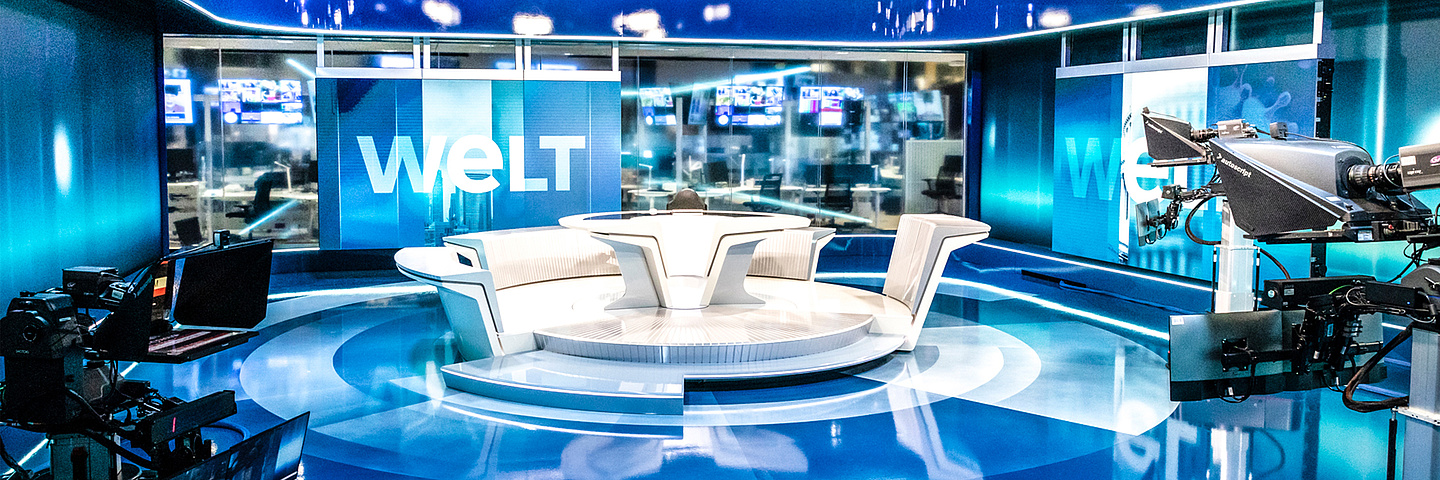
Brave new WELT
IP-based infrastructure by Qvest takes the Axel Springer SE news channel into the future
With information now available anytime, anywhere, professional reporting is subject to a growing number of requirements: Journalists must contextualize and clearly explain complex situations and intricate relationships under ever greater time pressure. To ensure that this happens, Axel Springer SE has set up a brand-new media center with state-of-the-art technology – including two news studios for the WELT news brand that are well ahead of their time: The technology and look have been designed to enable journalists to respond quickly to any situation, including breaking news. Qvest has planned and implemented a future-proof, flexible IP infrastructure for broadcasting operations. With a scalable design and the potential to accommodate extensive expansions, this infrastructure sets new standards for broadcasting
The task: A future-proof production environment
Axel Springer SE is one of the leading publishing and media companies in Europe. The company already owned strong print and digital brands such as "Die Welt," "Welt am Sonntag" and "Welt Online" when it acquired the news channel N24 in 2014. Since 2018, the cross-media news offering has been united under the WELT brand. The media company decided to physically combine the editorial staff for digital, print, and televisual content under one roof as well: The plan was for WELT to move into the impressive, newly built Axel Springer premises in Berlin in 2021 and to be able to respond as quickly there as BILD, another Axel Springer SE brand, does online. To make this possible, it was first necessary to create a future-proof media infrastructure at the new location – focusing on shared use: With a centrally networked, IP-based infrastructure, studios can be freely assigned and used by the three affiliated management teams. Qvest was commissioned to plan, develop, and implement the entire infrastructure and all the broadcasting technology. As the general contractor for the project, Qvest accompanied and was responsible for every stage of the project, from the design phase right through to completion.
The aim: A seamless live workflow
Spectacular, avant-garde architecture. Open, multifunctional spaces for flexible use. With 10 terrace-style stories connected by 13 bridges, these are the newly built Axel Springer premises designed by Rem Koolhaas and located in Berlin. Under one roof and across 52,000 square meters, more than 3,000 Axel Springer SE employees are working to make analog business models digital. To make this possible, it is essential that the system landscape is future proof and links tech solutions for live video, automated studios, management, editing, news production and news distribution, thereby ensuring a seamless workflow.
The requirement: Maximum flexibility
One of the key questions was: Which system architecture should be used on the Axel Springer Campus? When plans for the move from the old high-rise into the new building directly opposite first began to take shape, the transition from SDI to IP technology was foreseeable but the technical aspects had not yet been fully developed. Therefore, an SDI or proprietary IP solution were also initially under consideration as possible platforms. After intensive analysis and planning, an IP solution based on COTS (commercial off-the-shelf) technology was chosen – together with the SMPTE standard ST 2110. This fundamental change was a real challenge for the publisher and completely transformed the way in which content is produced, made available and marketed: A large number of systems and workflows had to be converted and employees supported through the transition. However, in the view of Norman Tettenborn, Principal and Project Manager at Qvest, the advantages are overwhelming: "Mapping the video infrastructure via network has proven to be an extremely flexible approach. Choosing SMPTE ST 2110 was therefore the only right decision. The technology is now fully developed and allows large, complex installations like this one. The current expansion for BILD Live highlights the scaling potential and validates the decision in favor of this technology."
The approach: A transition from SDI to IP technology
From day one, the project managers at Qvest took into account the fact that the relevant systems installed in the Axel Springer new building and high-rise use IP networks, as do many of the components. Together, the systems and components form one large network that has been designed and implemented by Qvest. In total, around 200 kilometers of cable were installed – 90% of which was used purely for the necessary network connections, along with 49 kilometers of fiber-optic cable and 133 kilometers for CAT.
The environment created in the new building – the SMPTE ST 2110 network, the broadcasting IT network and the KVM network from Black Box – was supplemented with the necessary production technology. Studio play-out servers from Harmonic enable signal distribution in the required IP standard. Central control tasks are handled via the Nevion orchestrator VideoIPath and the Lawo broadcast controller VSM. Another innovation is the mixerless workflow developed by Qvest and WELT in which image signals are combined without using a vision mixer. Instead, various software solutions from Vizrt were integrated to automate the vision mixing. Another new element is the editing system. With Octopus NRCS, journalistic content can be made available immediately on all channels, including via linear distribution, smartphone, website, social media, and TV app.
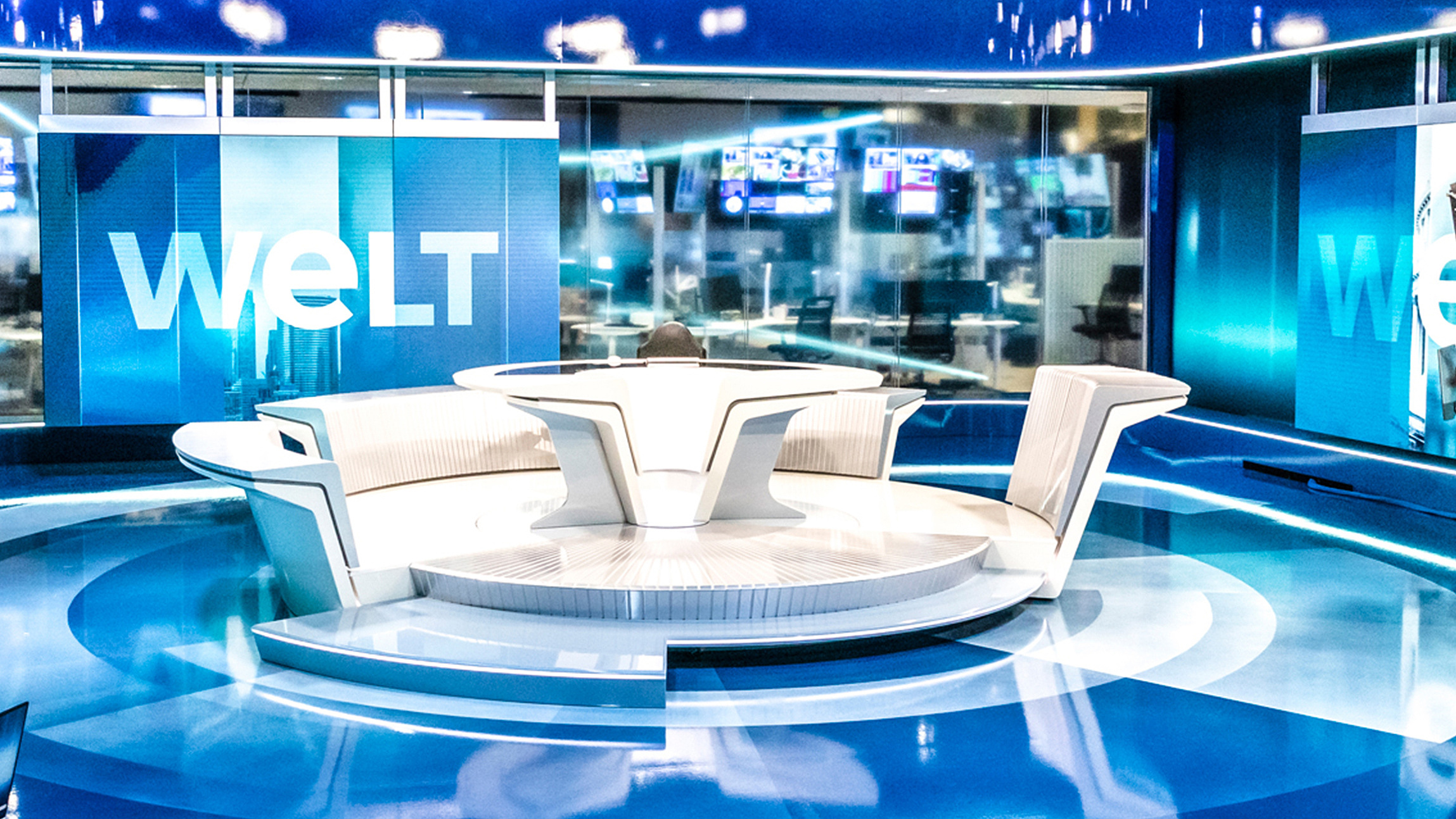
The implementation: LED walls, robotics, light, graphics, video – highly automated
A key feature of the Axel Springer building is the new news studios, including the complete, essential working environment for editorial planning, video and audio production and video-postproduction, live studio operation, signal distribution and signal contribution. Offering a high level of flexibility and automation, these are two of the most cutting-edge studios in Europe. Since 2021, this has been where all news programs have been created for WELT, but also for the ProSieben television network, as well as television channels SAT.1 and kabel eins. All the technology is designed for compact news broadcasting that is fast, informative, and clear.
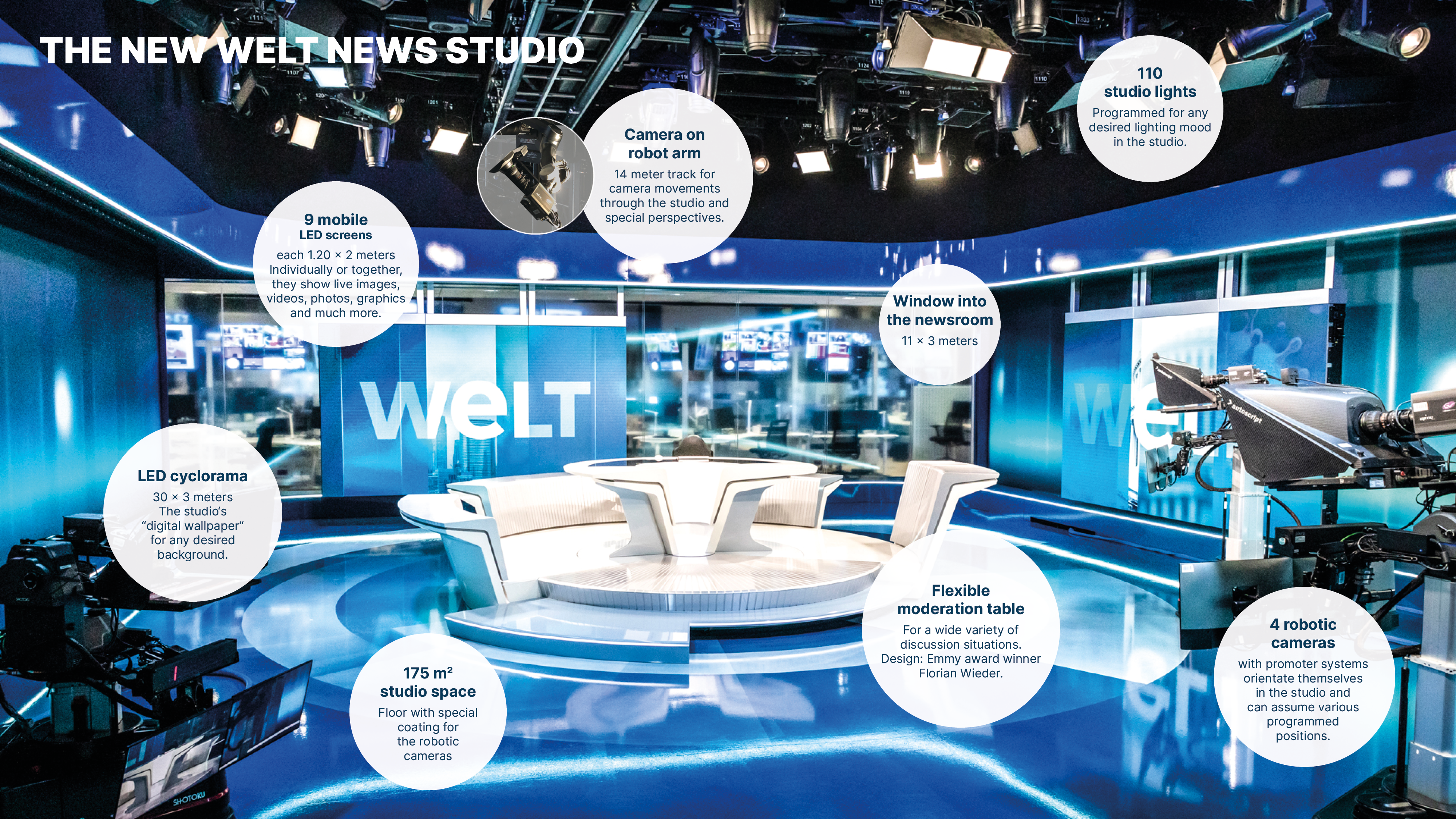
This is particularly true of studio 1, a 175-square-meter studio that is full of technical highlights and equipped with physical elements in the space – something of a rarity now that many studios use purely virtual visualizations. Backgrounds, color moods and lighting can be precisely adjusted and changed with the touch of a button, in particular thanks to one key design element: the mobile LED walls, which are based on Aoto technology and positioned in the background. The walls consist of nine segments that can be moved during live operation. They can be activated and played individually or in any combination and, if desired, can be joined together to form one large screen. For example, the panels can be arranged so that the editing room is visible behind the presenter – this emphasizes the live nature of the program. Particularly impressive is an enormous 30-meter-long cyclorama that encompasses the entire studio. The system from ETC-Europe can be used to display images relating to any topic and alter the atmosphere in the studio as often as required. The set is captured by four Grass Valley cameras that move autonomously around the studio thanks to robotics from Shotoku. There is also a flying camera to facilitate dynamic tracking shots, long shots and effect shots. To create the desired light mood in each scenario, the studio is lit by luminaires from ARRI. All the lighting technology is integrated in the broadcasting automation and controlled via an IP-based control system. This makes the solution more flexible and less prone to failures than a DMX controller. Studio 2 is a hybrid studio, composed of a built-in set and a green screen shaped as an infinity curve. Talk shows are created in the "real" area, whereas the formatted news for ProSieben, SAT.1 and kabel eins is created in front of the green screen.
The commissioning: During the pandemic
In addition to the enormous technical challenges, there were also significant practical issues to overcome because the work on the studio began during the pandemic. This meant that many of the parties involved had to take completely new approaches for this project. Some suppliers were never able to set foot on the construction site. Aside from the actual studio construction, the installation of the technical components and the cabling, the system was installed and configured entirely remotely. Despite all the pandemic-related difficulties, the project was successfully completed in time to start broadcasting all show formats in April 2021.
The future: State-of-the-art equipment for many years
With the successful transition to IP, WELT has replaced a broadcasting technology that had developed over the years but had ultimately become outdated. The result has been the creation of one of the most innovative news channel platforms. All the elements are perfectly tailored to one another: the network architecture, the IP-based connections, the mixerless workflow, the IP-based light, the autonomous tracking shots, performances in the studios in various directions, the LED walls that can be moved (even during live operation), and the full-screen LED cyclorama in the background. According to Norman Tettenborn: "The technical components are also designed to harmonize with one another even in the future – for example, after any expansions. This is already relevant for the integration of the new studio for BILD Live. Production is scheduled to begin here in 2022."
Image rights: WELT
